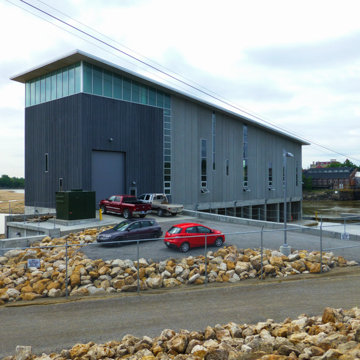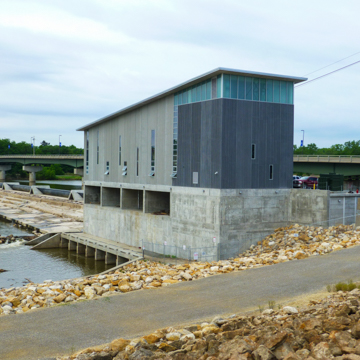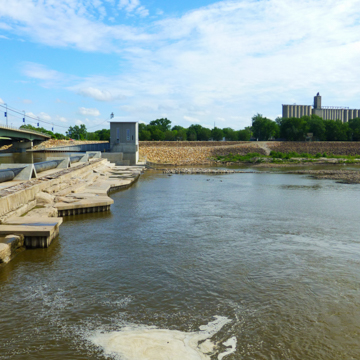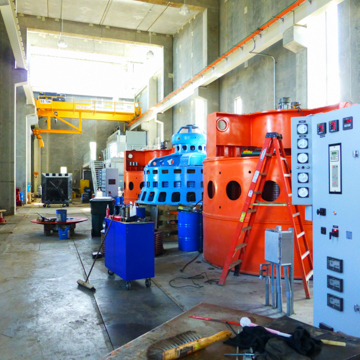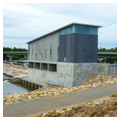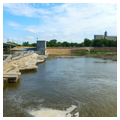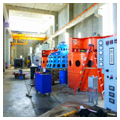The Bowersock North Shore Power Plant is a striking building on the north edge of the Kansas River, adjacent to the main bridge connecting Lawrence to North Lawrence. Owned by the Bowersock Mills and Power Company, this industrial facility is the only operating hydroelectric power plant in Kansas, and is unique in that it aspires to be a civic monument.
The first effort to build a low-head dam at this spot in the Kansas River was undertaken in 1874 by miller Orlando Darling. In 1880 J. D. Bowersock acquired and improved the dam, selling power to nearby customers. In 1905 Bowersock’s company built a sophisticated power generation facility on the south bank of the river. It was soon clear that the generators in this new facility were not able to take full advantage of the river’s potential energy. Although plans were drawn in 1924 for the addition of turbines on the north side of the river, in the 1930s Bowersock’s heirs sold the facility. When Bowersock’s great grandson, Stephen Hill, bought the facility back in 1972, he revived the idea of adding additional generating capacity.
Steven’s energetic and resourceful daughter, Sarah Hill-Nelson, assumed leadership of the operation. She was able to form strategic coalitions and secure a $25 million loan through the Federal Recovery Act of 2009. Hill-Nelson secured the services of the engineering firm Olsson Associates and those of the Lawrence-based architect Dan Sabatini of Sabatini Architects. Her choice of consultants was acute: Olsson Associates had provided comprehensive engineering services on a wide variety of large infrastructure projects, and Sabatini Architects, while a much smaller firm, had earned a reputation for producing ecologically responsible and appropriate solutions to difficult challenges. The success of the North Shore Power Plant was dependent upon the collaborative and synergistic efforts of the client and her team of consultants.
Construction began in 2011 with preparation of the site. Since much of the structure was to be submerged in the river, a waterproof dike was built forty-three feet below the water’s surface. A plunge pool is located at the bottom, and allows the water to exit below the dam. Above this is the turbine chamber where the power of the incoming water is transferred to the generators, which are located in the machine hall above. A space between the turbine chamber and the machine hall allows high water to pass through the building unencumbered. All of the submerged portions of the building are made of cast-in-place concrete, and the machine hall is clad in precast concrete panels.
The machine hall is a tall, narrow space that accommodates a row of four generators, two new units, and two refurbished ones. The concrete frame of the building supports a moveable gantry, which can be used to lift the machinery. Tall, narrow slot windows let in light and ventilation from the east and west. The metal-clad roof slopes up to the north. A clerestory window at the top of the north wall lets in cool, even light in the daytime, and at night becomes a beacon that welcomes visitors entering Lawrence from the north.
The other major phase of the North Shore Power Plant was the reconstruction of the dam. Previously, the height of the dam was adjusted by adding or removing wooden flashboards. The work, which was done by hand, was both strenuous and dangerous. The new dam was capped by inflatable rubber bladders, which could automatically adjust the height of the dam. In fall 2013, construction was completed.
The four generators in the North Shore Power Plant join the four smaller generators in the old south bank machine hall. The overall output from the facility fluctuates between 2.35 and 7.0 megawatts per hour. The electricity is sold into the power grid. While this is a modest contribution to the area’s power in the overall scheme of things, it is a step toward sustainability. Perhaps more importantly, the Bowersock North Shore Power Plant is a handsome reminder of the importance of environmental stewardship and serves as a symbol of Lawrence’s commitment to progressive ideals.
References
Haverkate-Ens, Bert. Bowersock: Construction of the North Powerhouse and millpond dam, 2011–2012.CreateSpace Independent Publishing Platform, 2013.






